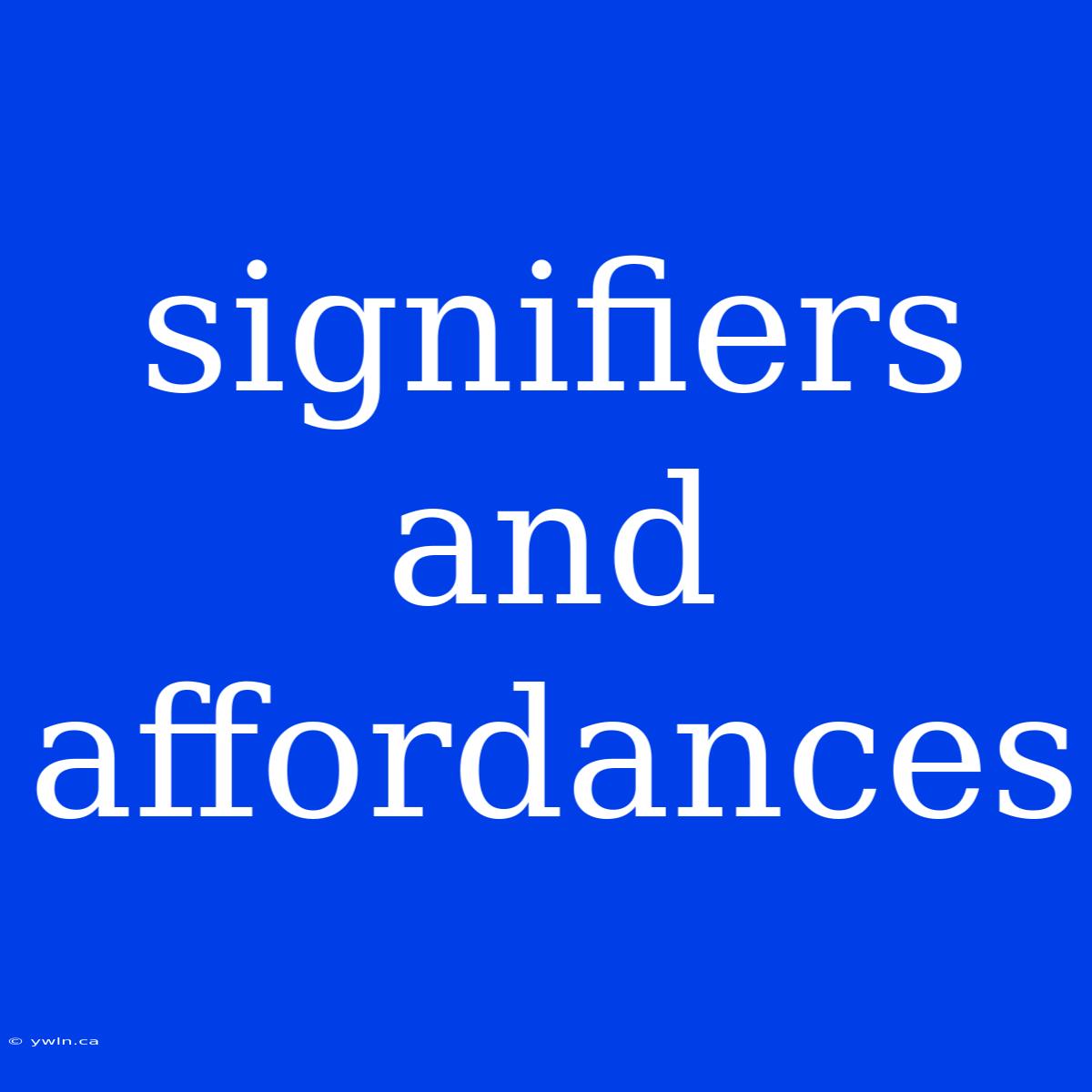Unlocking the User Experience: Signifiers and Affordances
Have you ever wondered why you instinctively know to click a button on a website or how you effortlessly navigate a new app? The answer lies in the subtle yet powerful interplay of signifiers and affordances.
Editor Note: The interplay of signifiers and affordances is crucial for creating intuitive and engaging user experiences. Understanding these concepts can help designers and developers create interfaces that are both visually appealing and functionally effective.
Analysis: This exploration dives into the world of signifiers and affordances, examining their significance in user interface design. We'll delve into how these elements guide user interaction, providing practical examples and insights that can enhance your design process.
Key Takeaways:
| Aspect | Description |
|---|---|
| Signifiers | Visual cues that communicate potential actions |
| Affordances | The perceived capabilities of an object or interface element |
| Alignment | How well signifiers and affordances work together |
| Perceived Usability | The ease with which users can understand and interact with a system |
Signifiers
Signifiers are the visual cues that hint at the potential actions a user can take. These cues can be as simple as a button's shape or color or as complex as a visual animation. They guide the user's attention, providing clear clues about what can be done.
Key Aspects:
- Types of Signifiers: Icons, labels, colors, shapes, animations, and even sounds.
- Purpose: To communicate potential actions and reduce ambiguity.
- Impact: Improved user understanding and reduced learning curves.
Discussion: Signifiers are essential for guiding user behavior. Consider a website's navigation menu: clear visual cues like bold fonts, contrasting colors, or arrows communicate its purpose, making it easy for users to find their way around.
Affordances
Affordances, on the other hand, refer to the perceived capabilities of an object or interface element. They tell the user what actions are possible, even if the user has never interacted with the object before.
Key Aspects:
- Perceived Functionality: The user's understanding of what an object can do.
- Physical Constraints: The limitations imposed by the object's design.
- Conceptual Affordances: Actions implied by the object's design, even if physically impossible.
Discussion: A door handle, for instance, has a clear affordance: it's designed to be grasped and pulled. The user understands that it can be used to open the door, even without prior experience. In a digital context, a clickable button has a clear affordance: it's designed to be clicked, suggesting a potential action.
Alignment of Signifiers and Affordances
The key to a successful user interface lies in the alignment between signifiers and affordances. If the visual cues (signifiers) accurately reflect the functionality (affordances), users will find it easy to interact with the system.
Key Aspects:
- Consistency: Similar elements should have similar functionality.
- Clarity: Visual cues should be clear and unambiguous.
- Mapping: The correspondence between signifiers and affordances should be intuitive.
Discussion: Consider a website's "Submit" button. The button might be visually distinct with a contrasting color and rounded corners (signifiers), and clicking it sends the form data (affordance). This clear mapping between visual cue and functionality makes the interaction intuitive.
Perceived Usability
The interplay of signifiers and affordances significantly influences the perceived usability of an interface. When these elements work in harmony, users can quickly understand the system's functionality and interact with it efficiently.
Key Aspects:
- Reduced Learning Curves: Users can quickly grasp how to use the interface.
- Enhanced User Experience: Intuitive interactions lead to a smoother and more enjoyable experience.
- Increased User Satisfaction: Users are more likely to be happy with the interface if it's easy to use.
Discussion: When signifiers and affordances are well-aligned, users can navigate the interface effortlessly, leading to a positive user experience. This is essential for websites, apps, and any digital product that aims to engage and retain its users.
FAQs
Q: Are signifiers and affordances the same thing?
A: While they are closely related, they are distinct concepts. Signifiers are the visual cues that communicate potential actions, while affordances refer to the perceived capabilities of an object or interface element.
Q: How do I design effective signifiers?
A: Consider using clear and consistent visual cues like icons, labels, colors, shapes, animations, and even sounds. Test your designs with users to ensure they are easily understood.
Q: Can affordances be misleading?
A: Yes, if the design doesn't accurately reflect the object's functionality. For example, a button that looks like it can be clicked but actually isn't interactive is a misleading affordance.
Q: What's the role of cultural context in signifiers and affordances?
A: Cultural context can influence the perception of both signifiers and affordances. What is intuitive in one culture might be confusing in another. It's important to consider cultural variations when designing user interfaces.
Tips
- Emphasize Consistency: Use consistent visual cues throughout the interface.
- Prioritize Clarity: Avoid ambiguity in your signifiers.
- Test Early and Often: Gather feedback from users to ensure your design is intuitive.
- Be Mindful of Cultural Differences: Consider how cultural context might influence the perception of signifiers and affordances.
- Keep it Simple: Avoid overcomplicating your design with unnecessary visual cues.
Summary
By understanding the interplay of signifiers and affordances, designers can create intuitive and engaging user experiences. Through careful consideration of visual cues, perceived functionalities, and user feedback, interfaces can be designed to be both visually appealing and functionally effective.
Closing Message: The ability to effectively communicate potential actions through signifiers and affordances is a fundamental skill for user interface designers. By applying these principles thoughtfully, you can unlock the potential for truly engaging and intuitive user experiences.

